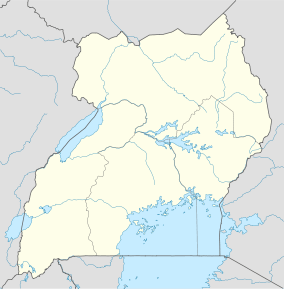Uganda Oil Refinery
| Uganda Oil Refinery | |
|---|---|
 Uganda Oil Refinery | |
| Country | Uganda |
| Location |
Kabaale Township Buseruka Subcounty Hoima District Western Uganda |
| Coordinates | 01°30′00″N 31°04′48″E / 1.50000°N 31.08000°ECoordinates: 01°30′00″N 31°04′48″E / 1.50000°N 31.08000°E |
| Status | Planned |
| Commission date | 2018 (Expected)[1] |
| Power generation | |
| Maximum capacity |
(a) Initially 30,000 bbl/d (b) Increase to 60,000 bbl/d by 2020 (c) Reach 120,000 bbl/d in 2022[2] |
The Uganda Oil Refinery (UOR) is a planned crude oil refinery in Uganda.
Location
The refinery will be located on a 29 square kilometres (11 sq mi) piece of real estate in Kabaale Township, Buseruka Sub-county, Hoima District, Western Uganda, along the eastern shores of Lake Albert, near the international border with the Democratic Republic of the Congo (DRC). This location lies close to Uganda's largest oil fields in the Kaiso-Tonya area, approximately 40 kilometres (25 mi), by road, west of Hoima, the nearest large town.[3] Tonya lies approximately 260 kilometres (160 mi), by road, northwest of Kampala, Uganda's capital and largest city.[4] The approximate coordinates of the refinery are:+1° 30' 0.00", +31° 4' 48.00" (Latitude:1.5000; Longitude:31.0800). The coordinates are approximate because the refinery does not yet appear on most publicly available maps.
Overview
Starting in 2006, Uganda has discovered proven reserves of at least 3.5 billion barrels, of crude oil, of which at least 50% is recoverable. The reserves are the fourth-largest in sub-Saharan Africa, behind Nigeria, Angola and South Sudan.[5] Some of the largest oil fields are located in the Kaiso-Tonya area in Hoima District. This area has been selected to be the location of Uganda's only oil refinery.[6] The strategy is to build a refinery that meets the petroleum products needs of Uganda and its regional neighbors and to export the rest of crude oil production via a pipeline to Kenya's port of Lamu.[7]
History
The Government of Uganda has, from the beginning, preferred a small production capacity, to prolong the production longevity of its new oil discoveries. This preference initially pitted it against the three major exploration companies in the country, which preferred rapid harvesting and export of the crude via pipeline to the Kenyan coast.[8] Finally in April 2013, the government reached an agreement with Tullow Oil of the United Kingdom, Total of France and the China National Offshore Oil Corporation (CNOOC), to build both the oil refinery and the pipeline.[9] Uganda has partnered with the neighboring countries of South Sudan, Kenya and Rwanda to take up ownership in the planned oil refinery. Once the remaining issues are worked out, construction is expected to start in 2014, with commissioning expected in 2018.[10] In October 2013, the government of Uganda invited interested parties to bid for the construction, operation and 60% ownership of the refinery in a public-private partnership (PPP) arrangement.[11]
Construction costs
The exact construction bill has yet to be worked out. In addition to the refinery, a new airport, a road network within the community, a modern road linking the new development to Hoima and a hospital are all planned. Also in the pipeline is Nzizi Power Station, a 52MW thermal power plant, using both natural gas and heavy fuel oil as raw materials. Two intake pipelines and one distribution pipeline, all with a total construction bill of over US$200 million, are also planned to bring crude from the oil fields to the new refinery and to distribute the finished products to a new terminal in Buloba, on the western outskirts of Kampala.[12]
Owners
The government of Uganda has engaged the US-based energy investment and consulting firm of Taylor Dejongh, to carry out an international search for a strategic investor in the Uganda Oil Refinery.[13] In July 2013, China National Offshore Oil Company (CNOOC), expressed interest in investing in both UOR and in the proposed oil pipeline to the Kenya coast.[14][15] As of September 2013, the proposed shareholding in UOR is as illustrated in the table below:[16]